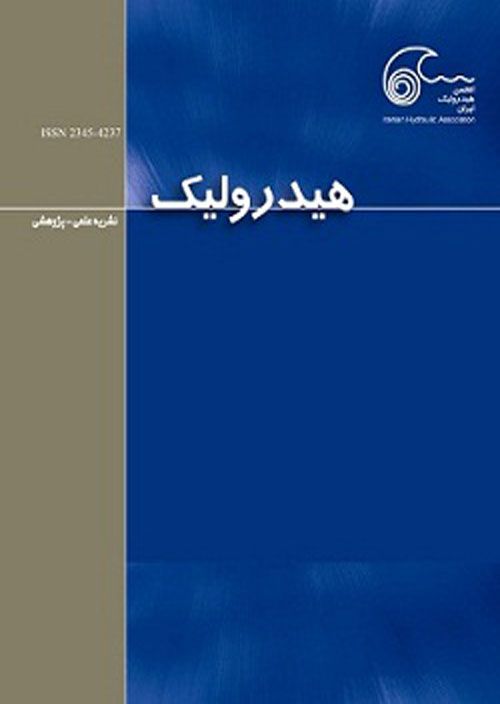فهرست مطالب

مجله هیدرولیک
سال دوم شماره 3 (پاییز 1386)
- تاریخ انتشار: 1386/09/01
- تعداد عناوین: 6
-
-
صفحات 43-62
-
Pages 1-13
One of the common ways of dissipating the excess kinetic energy downstream of dam spillways is the use of flip-bucket. Usually a scour hole is created on the river bed at the point of jet impingement which may cause damage to the structures. Riprap can be used to stabilize the river bed. It is the main purpose of this study to develop design criteria for riprap size. To reach such a goal, first general relations were developed at the point of the incipient motion and failure condition for riprap. These relations were developed based on the stability criteria of riprap particles using dimensional analysis. Then extensive experimental tests were conducted in a physical flume. Five different sizes of riprap materials were tested under different flow conditions. Analyzing many linear and none-linear equations, the best fit relations were developed and presented. Other tests also were conducted to establish the filter criteria which must be placed beneath the riprap materials to prevent escaping of the fine materials.
-
Pages 15-25
This paper describes the application of artificial neural networks to model the longitudinal dispersion coefficient, which is a key hydraulic parameter included in the advective-diffusion equation (ADE).The dimensionless dispersion (Dl/HU*) has been modeled based upon four dimensionless hydraulic parameters, including: the relative roughness (ks/H), the aspect ratio (H/W), the relative shear velocity (U*/U) and the Reynolds number (UH/v). A total of 81 sets of measured data in small and large rivers from the current literature were used to establish and verify the ANN model. The final model has been compared favorably with two recent formulations published in the literature. Comparison of the results showed that the ANN model is able to predict the measured values more precise by (14%) than the other two considered models.
-
Pages 27-42
Energy and momentum approaches can lead to different results in analysis of flow through compound channels. This study is an attempt to shed more light on the validity of these approaches for analysis of gradually-varied flow in compound channels. At first the energy and momentum equations and a generalized form of steady gradually-varied governing equation are introduced. This G.E. provides a framework to highlight the differences between the two approaches using some numerical examples. Then, experimental data available in the literature and those collected in this study are used to compare different numerical water surface profiles with laboratory measurements. This study indicates that the momentum principle can perform better for water surface profile computation in compound channels, at least for the investigated experimental data. Error analysis also supports this conclusion. Two dimensional Shiono and Knight method for velocity distribution is employed to study more on the subject. In addition, two dimensional analyses introduces a procedure by which one can decide on the superiority of one approach over the other, based on geometrical and hydraulic characteristics of a compound channel, with no need for experimental work.
-
Pages 43-62
A two-dimensional numerical model, based on solution of the Reynolds-averaged navier-stokes equations with k-eand EASM (explicit algebraic stress) turbulence models, is presented to describe' the free surface water flow over bed topography (dune) in open channels.The model application indicates insufficiency of k-e turbulence model for simulation of flow over dunes (because of separation and streamline curvature). In this case, algebraic stress model that is economic method for calculating stresses can do better. Therefore, an explicit version of it (Wallin and Johanson 2000) is used All of the differential equations are solved with a finite volume method in a nonstaggered grid. The geometric shape of sand dune is simulated by introducing a general non-orthogonal curvilinear coordinate system.The numerical results were compared with the available experimental data reported by Mierlo and Ruiter (1988) and general agreement was observed. Detailed calculations indicate improving prediction of turbulence characteristics and length of separation zone by EASM model.
-
Pages 63-71
In recent decades, various formulas have been developed to achieve a better evaluation of the characteristics of rivers and natural channels. In this article we compare some of well-known classical methods in estimating stable sections are compared. Also two non-linear functions have been used to design the width and depth of canals and sand bed rivers with the formulations which have been obtained from 70 natural canals in North-America. Genetic Programming (GP) and Group Method of Data Handling (GMDH), two methods in soft computing family, have been used in this research.Finally these methods have been compared with three general methods in designing stable canals. In this modeling, in addition to flow parameters like discharge (Q), sediment quality as average bed particles diameters (D50), and channel slope (S) have been used. The results show that GMDH is more accurate than other methods. Finally sensitivity analysis has shown the effect of each parameter used in the best model.
-
Pages 73-79
Under low flow conditions, one of the major concerns in gravity intake from rivers is the low water intake efficiency. This occurs when the river thalweg lie too far from the intake area. In the present study, the effect of application of groyne at the opposite bank on intake flow efficiency is investigated using a laboratory flume The main channel of the flume was 30 m long, 1.5m wide with a 2.5 m short intake channel of a width of 60 em. The two channels were jointed to each other by angle of 60 degrees. Three different lengths of groynes under three flow discharge conditions were investigated experimentally. The experimental results were then compared with no groynes. The results showed that channel thalweg is developed near intake side of the main channel when the groyne is used. Furthermore, the results highlighted an increase in flow efficiency and a reduction in sediment intake when the groyne was employed.


